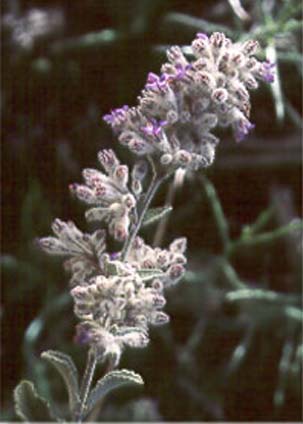Hyptis emoryi

Common: Desert-lavender
Family: Lamiaceae
Origin: Occurs to 3,000 ft elevation in southern California, Nevada, Arizona, New Mexico, and Baja California and Sonora, Mexico.
Light: Full sun encourages dense growth. In partial shade, foliage will be sparser.
Soil: Well drained
Water: Drought tolerant. Will benefit from infrequent soakings during warm season, until late summer, when water should be withheld to harden plant for winter.
Temperature: Foliage damage if temperature drops in the low 20s F. Plant may freeze to ground in severe winters, but should re-sprout and will probably grow back bushier than before.
Grows on dry, rocky slopes, along washes and in canyons. Attractive in most desert landscapes. Use as informal hedge, privacy screen.
Branches grow upright to form an evergreen shrub 10 ft. high and 8 ft. wide. Natural growth form is compact.
Leaves are 1 inch long and 3/4 inch wide, broader at base than tip. Edges have rounded teeth. Leaves are gray, covered with fine hairs, and are soft to the touch. Pleasant lavender scent is released following rains or if you brush against the foliage. Spikes of silvery-blue flowers develop at end of branches anytime throughout year, but appear most heavily in spring. Bees frequent the flowers, and birds often nest in the branches.
Fragrant foliage is best appreciated near patio or in entryway. Fall pruning, which would stimulate frost sensitive new growth, should be avoided. Since natural form is compact, pruning is optional.